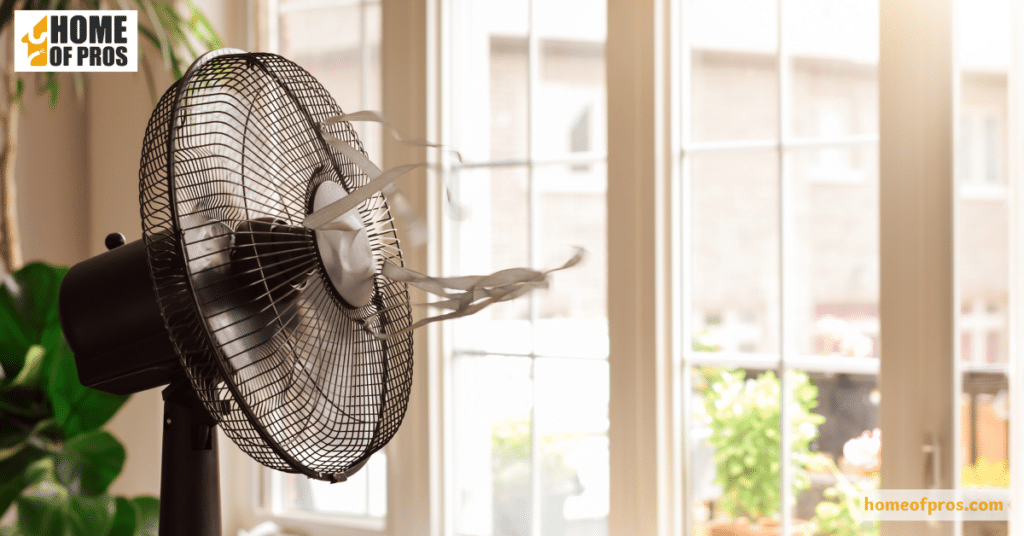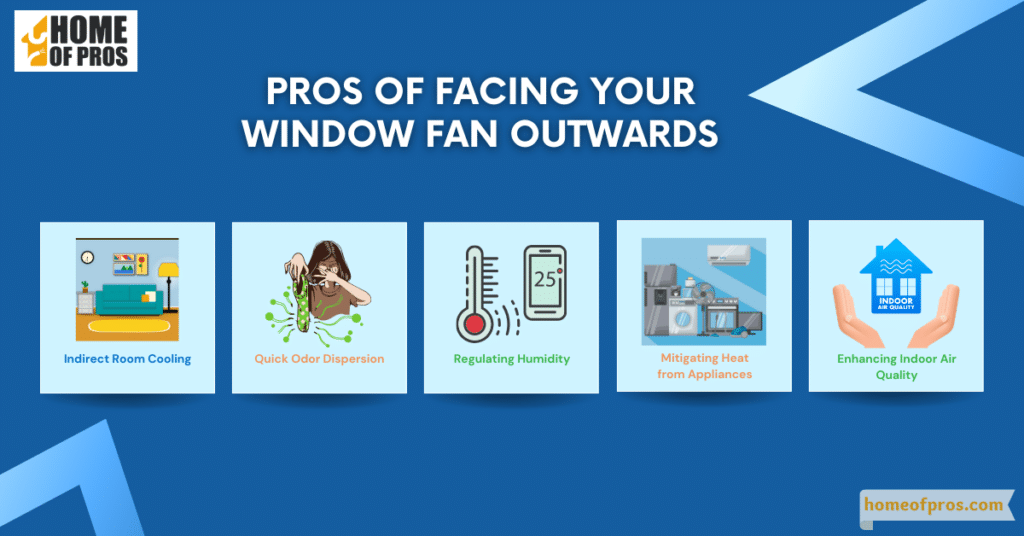The position of your window fan can seem like a minor detail, but it plays a pivotal role in optimizing comfort, energy efficiency, and air quality in your space. While many of us instinctively position our fans based on the day’s weather or our mood, there’s genuine science behind the best direction for different scenarios.
The direction of your window fan can significantly impact your room’s comfort and air circulation. Facing it inwards draws cooler air from outside and promotes fresh airflow. Conversely, facing it outwards expels stale or warm air, creating a vacuum that pulls in cooler ambient air.

The Science Behind Fan Airflow
Fans influence and manage airflow in our spaces. Their blades, when rotating, either draw in external air or expel internal air. This simple mechanism can lead to either positive or negative air pressure within a room.
Fan Mechanics and Air Movement
As fan blades turn, they push air in one direction while pulling it from the opposite. In window fans, blades can bring in fresh outside air when facing inwards or send out room air when facing outwards.
Positive and Negative Pressure Explained
- Positive Pressure: If a fan pushes more air into a room than it expels, it creates a positive pressure. This keeps external pollutants at bay, as the room’s air pressure pushes against incoming air.
- Negative Pressure: When a fan expels more air than it brings in, a negative pressure is formed. Useful for removing odors or contaminants, this vacuum effect consistently draws air out.
Impact on the Room
- Drawing in Air: Pulling in outdoor air can refresh a room, especially during cooler times or when the inside air feels stale.
- Expelling Air: Pushing air out removes warm or polluted air, and in turn, cooler air from other parts of the house or other windows is drawn in.
In essence, using the principles of fan airflow and understanding pressure dynamics can help maximize a window fan’s benefits, ensuring optimal room comfort.

Pros of Facing Your Window Fan Inwards
Utilizing a window fan by facing it inward can offer a series of advantages, particularly when the objective is to rejuvenate and cool a room. Here are some of the key benefits:

- Natural Cooling: Drawing in cooler external air, especially during the evening or early morning, can effectively reduce indoor temperatures. This not only makes the environment more comfortable but can also offer a sustainable alternative to air conditioning, leading to energy savings.
- Freshness and Improved Air Quality: Outside air, especially from environments with plants or away from city pollution, tend to have better air quality. By drawing it in, you’re essentially giving your room a breath of fresh air.
- Elimination of Indoor Pollutants: Rooms, especially those that are well-sealed or lack regular ventilation, can accumulate pollutants such as dust, pet dander, or even volatile organic compounds (VOCs) from certain paints and furnishings. By introducing fresh air, you’re diluting the concentration of these pollutants, creating a healthier living space.
- Odor Neutralization: Stuffy or odorous environments, whether from cooking, pets, or other activities, can be quickly refreshed by drawing in the outside air. This natural ventilation process helps dissipate unwanted scents, replacing them with neutral or naturally scented outdoor air.
- Humidity Regulation: In certain conditions, external air can be less humid than indoor air, especially in homes where activities like cooking or showering have increased humidity levels. Introducing this drier outside air can help maintain a comfortable humidity balance in the room.
Facing your window fan inwards provides a natural, energy-efficient way to refresh and enhance the quality of indoor environments. It’s especially beneficial for rooms that feel stuffy, overly warm, or have lingering odors, ensuring a pleasant and healthy atmosphere.
Pros of Facing Your Window Fan Outwards
Positioning a window fan to expel indoor air offers its own set of advantages. While it may seem counterintuitive to some, this method can indirectly cool and refresh a space. Here’s how:

- Indirect Room Cooling: An outward-facing window fan expels warm air, creating a vacuum that draws cooler air into the room from other areas or shaded outdoors.
- Quick Odor Dispersion: After activities like cooking, which can introduce strong smells into the home, an outward-facing fan becomes an efficient tool in expelling these odors.
- Regulating Humidity: In situations where indoor humidity is high due to activities like showering or boiling water, expelling this moist air helps reduce the overall humidity level in the room.
- Mitigating Heat from Appliances: Rooms that house heat-generating appliances, such as ovens, stoves, or even computers, can benefit from an outward-facing fan. By expelling the warm air these appliances generate, the fan helps to maintain a more stable room
- Enhancing Indoor Air Quality: While drawing in fresh air has its merits, expelling polluted indoor air is equally beneficial. This action ensures that contaminants or pollutants are pushed out before they have a chance to settle or be inhaled, thus promoting a healthier living space.
While facing a window fan outwards might not directly introduce fresh air, it offers an effective method for improving indoor environments. By expelling warm, stale, or odorous air, it paves the way for indirect cooling and enhances the overall comfort and air quality of a room.
Factors to Consider When Deciding Fan Direction
Making the most of your window fan requires a bit of strategic thinking. While the debate on inwards vs. outwards continues, the best direction often hinges on various factors in your immediate environment. Let’s break down these factors and provide some scenario-based guidance.
Table: Factors and Optimal Fan Direction
| Factor | Scenario | Optimal Fan Direction |
|---|---|---|
| External Temperature | Cooler outside than inside | Inwards |
| Warmer outside than inside | Outwards | |
| Room Activity | Cooking (strong odors) | Outwards |
| Exercising (need for fresh air) | Inwards | |
| Presence of Pollutants | High indoor pollution (e.g., smoke) | Outwards |
| Cleaner outdoor air quality | Inwards | |
| Humidity | High indoor humidity (post-shower) | Outwards |
| Drier outside, and humid inside | Inwards |
In the dynamic world of window fans, one size doesn’t fit all. The direction you choose can have a significant impact on your comfort, health, and energy efficiency. Remember to assess your specific needs and the conditions of your environment, and let them guide your fan direction for the best results.
Conclusion
The direction in which you position your window fan is more than a mere choice; it’s a strategic decision that influences the comfort, air quality, and energy efficiency of your living space. By understanding and weighing the various factors, from room activities to external temperatures, you can harness the full potential of your fan. Ultimately, it’s about striking a balance, being adaptable, and letting the specific needs of your environment guide your choices. With this knowledge in hand, you’re well-equipped to create a more pleasant and refreshing indoor atmosphere.











